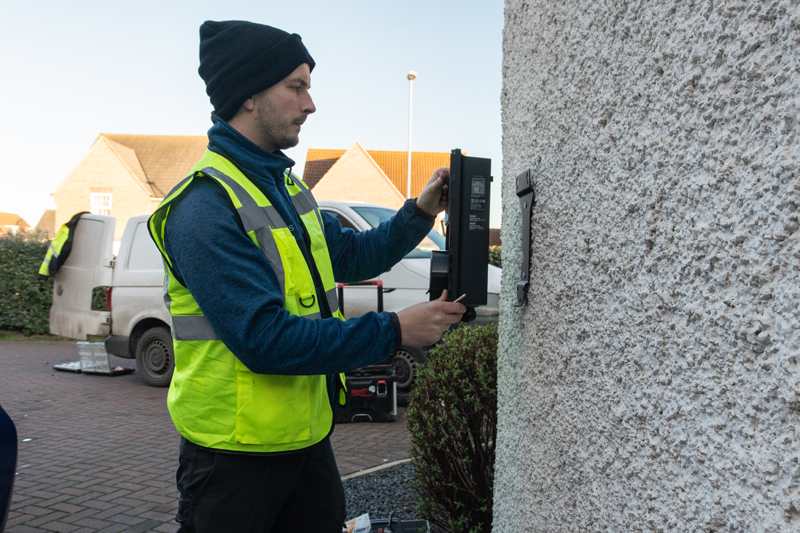
Simon Crangle of Sevadis advises on how to ‘get it right first time’ when installing EV charging systems for your clients.
The requirement for both domestic and commercial EV charging installations continues to rise as more drivers and businesses make the switch to electric vehicles. As EV charging systems play a critical role in a journey, getting the installation right the first time round is paramount.
The not so brief, brief
To truly understand the requirements of your customers, a brief is essential; a thorough brief of what your customer needs and wants will shape your installation journey.
There are some key questions to ask your customers here, including:
– What’s your supply?
– Do you require load balancing/managing?
– What type of charging do you require – is it AC or DC, or both?
– Who will be using the charging points?
– How do you wish to finance the purchase and installation of your charging infrastructure?
– Will you be taking advantage of grants?
– Does a maintenance package appeal?
– Do you foresee the requirement for more EV charging points at your property?
– Will you be opening the EV chargers up to the public, or are they for private use?
Whilst all these questions may seem extensive, it is better to know more than lacking an understanding of your customers’ objectives. Knowledge is power and in this circumstance, it will inevitably save time, money and manpower, in turn allowing for an efficient installation process.
Site surveys are a must
Without them, you risk spending more time and money than you need for a seamless EV charge point installation. In conjunction with the brief, site surveys form the crucial foundations for a straightforward installation; a site survey solidifies your approach to fulfilling the requirements of your customer, whilst also enabling you to understand and solve any challenges you may encounter.
If conducting the site survey and you predict potential obstacles along the way, it is worth liaising with key stakeholders who are involved in the installation journey, for example, your technical point of reference at your EV charging point provider. More than often, your peers can also support as some may have encountered similar challenges in their EV charge point installation careers.
Facebook pages such as UK EV Installers are the perfect place for such queries, encompassing a community of EV charge point installers who are quick to support with advice and feedback on all aspects of EV charging.
Choosing a quality solution
It goes without saying that getting it right the first time relies on the quality of the solution you choose to implement for your customers. Due diligence on EV charge point providers is advised to understand whether the EV charging point is fit for purpose, reliable and future-proof for your customers’ lifelong experience with EV charging.
Naturally, we’re led to opt for options that are cost-effective and those that don’t break the bank, but be sure to understand whether the solution delivers on the brief. The last thing you want is to encounter a scenario where you’re required to revisit your installation for repairs, or worse, replacements.
With the Sevadis MaxiCharger, both domestic and commercial applications can benefit from a quality solution without breaking the bank. Backed with its 0.76% fault rate and its feature-packed design, there is a solution for every location and requirement, accommodating all scenarios, whilst also providing one of the easiest installation processes in the industry. Quality solutions matched with easy installation makes for the perfect recipe for an efficient EV charge point installation journey; providing confidence from initial installation and beyond, and eliminating the requirement for costly call-outs.
Paired with a future-proofed back-office
Most, if not all customers, opt for the integration of a smart EV charging portal in the form of a back-office management system. Ensuring that you choose a hardware solution that can be matched with a back-office is crucial as this provides end-users, as well as charge point operators, with complete control over their EV charging points. OCPP compliant solutions are paramount in the future of EV charging due to their flexibility in offering a future-proof interoperable solution.
Before choosing your back-office solution, refer to your comprehensive brief and understand whether your chosen provider is capable of fulfilling the requirements of your customers. Whilst most back-offices offer similar functions, there may be specific requirements for unique features, such as charging without an App, scheduled charging, fleet solutions, multiple tariff setting and queuing/booking systems.
Maintenance and beyond
Particularly in the case of commercial EV charge point installations, your services don’t simply stop at installation of the charge points. More often than not, commercial customers will opt for a maintenance service to ensure their EV charging points are still fit for purpose throughout their lifetime. Upon consultation with your commercial customers, it is always worth discussing the potential of a maintenance package as this opens up further business for you down the line.
If maintenance packages aren’t part of your portfolio of services, liaising with your EV charge point partner, or third party maintenance providers, will provide you with options to present to your customers.
Don’t forget your training
Getting it right the first time is fuelled by product and technical installation training so it’s important to get your hands on your chosen EV charge point solution and really understand the ins and outs of the charger. For the best return on your money and to deliver a seamless EV charge point installation, pour your mind into education; knowledge is power, especially in the ever-evolving world of electric vehicles.
Get more details about the Sevadis MaxiCharger unit here











